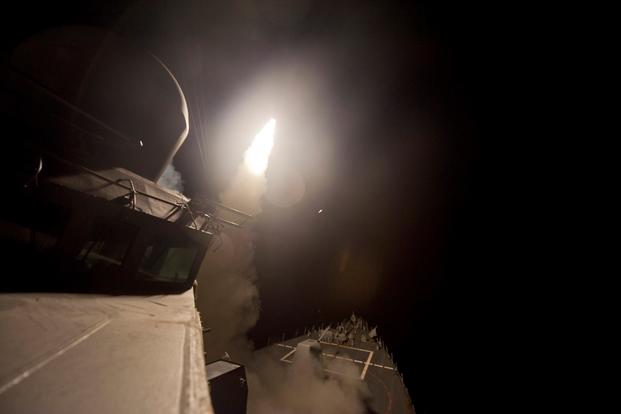A U.S. Navy ship launched cruise missiles and destroyed three radar sites from a rebel-controlled area in Yemen, the service announced late Wednesday.
The announcement came a day after a Navy ship was apparently targeted for a second time by missiles originating from the area.
In a statement, Pentagon spokesman Peter Cook said the radar sites struck were in territory controlled by Houthi rebels on Yemen's Red Sea coast. They were hit early Wednesday morning, at roughly 4 a.m. local time, officials said.
"Initial assessments show the sites were destroyed," Cook said in the statement.
A defense official told Military.com the attacks were conducted using sea-launched cruise missiles and originated from the Arleigh Burke-class destroyer USS Nitze, but would not confirm the number of missiles fired, citing security reasons.
"This is a direct response to situations that threaten freedom of navigation," Navy Lt. Ian McConaughey, a spokesman for U.S. Naval Forces Central Command, told Military.com. "These strikes show our resolve against unprovoked hostility against the U.S. and are aimed at defending U.S. Navy assets.”
The original attacks appeared to target the Arleigh-Burke class destroyer USS Mason, which has been patrolling near the Bab-el-Mandeb strait, and the amphibious transport dock USS Ponce, also in the region.
Related Video:
USS Nitze Fires at Radar Sites in Yemen
The strikes were recommended by Defense Secretary Ash Carter and Chairman of the Joint Chiefs of Staff Marine Gen. Joseph Dunford and authorized by President Barack Obama, Cook said in the statement.
"These limited self-defense strikes were conducted to protect our personnel, our ships and our freedom of navigation in this important maritime passageway," Cook said. "The United States will respond to any further threat to our ships and commercial traffic, as appropriate, and will continue to maintain our freedom of navigation in the Red Sea, the Bab-el-Mandeb, and elsewhere around the world."
Earlier Wednesday, a military official confirmed to The Associated Press that a second round of two missiles had been fired from rebel territory at the Mason. The ship used countermeasures, the officials said, and the missiles went harmlessly into the sea.
The first two missiles targeting the Mason and the Ponce were fired Sunday, originating from the same region on the coast of Yemen.
A defense official confirmed to Military.com that the Mason had used countermeasures, firing two Standard Missile-2s and a RIM-162 Evolved SeaSparrow Missile, and launching a Nulka missile decoy to lure the missiles away from the ship. It remains unclear whether these countermeasures were successfully employed against the missiles or whether the attack failed on its own.
A defense official told Military.com Wednesday's successful attack on radar sites in Yemen was executed consistent with international law and was conducted independently of the Saudi-led coalition war on the rebels.
McConaughey told Military.com that the command will continue to maintain ships in the area.
"[NAVCENT] will not back down from its duty to ensure the free flow of commerce, freedom of access and security in this vital region with our allies and regional partners," he said.
It remains unclear whether the U.S. will take further action in response to the attacks.
--Hope Hodge Seck can be reached at hope.seck@military.com. Follow her on Twitter at @hopeseck.




























